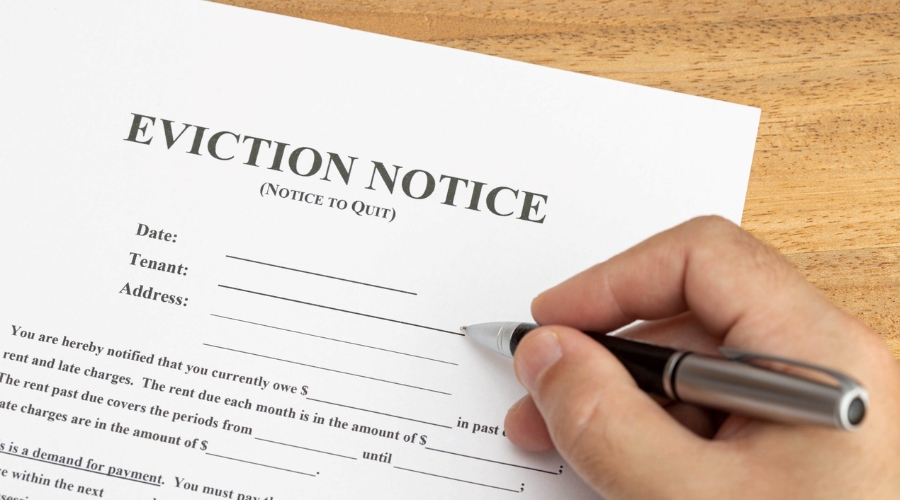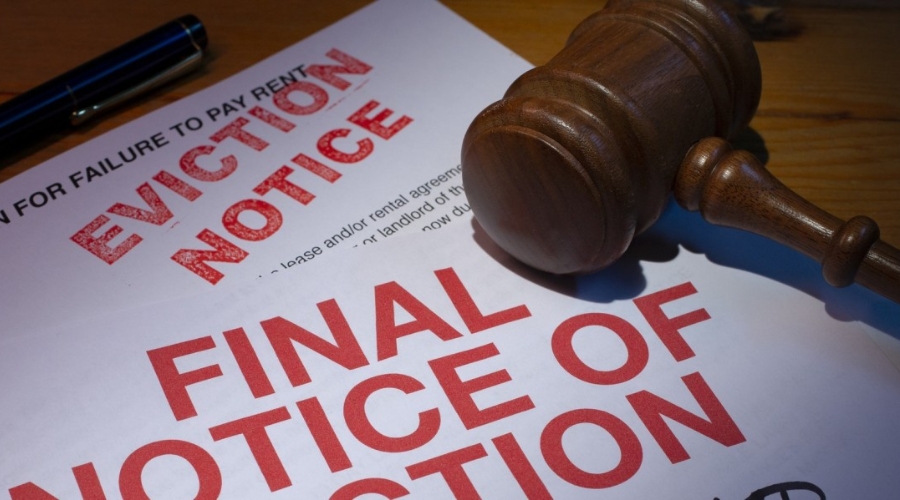Navigating the eviction process in Arizona can feel overwhelming, especially with strict notice requirements, county-specific rules, and tight legal timelines. Whether you’re a new or experienced landlord, knowing the right steps from the start can save time, money, and stress.
This guide breaks down practical tips to help you avoid delays, stay compliant with Arizona law, and protect your rental property while maintaining a smooth, legal process.
Key Points under the Arizona Residential Landlord and Tenant Act (ARLTA)
The Arizona Residential Landlord and Tenant Act (ARLTA) outlines several important protections and obligations for both parties in a rental agreement. Below are key provisions you should know, including rules on eviction procedures, repair remedies, and tenant rights when essential services are disrupted.
Prohibition of "Self-Help" Evictions
Arizona statutes strictly bar landlords from bypassing the courts to remove tenants. Actions such as changing locks, turning off utilities, or disposing of a tenant’s belongings without a judicial order are explicitly forbidden. These illegal evictions violate the law and may result in tenant compensation for damages. This prohibition underscores that any effort to enforce eviction must follow proper legal procedures - not through unilateral actions.
"Repair and Deduct" Remedy
When property defects arise that the landlord fails to address, tenants may take corrective action under ARS § 33-1363. If the repair costs are under $300—or up to half of a month’s rent, whichever is greater—the tenant may:
- Inform the landlord in writing of your intention to make the repairs at their expense.
- Wait the 10-day statutory window for correction (shorter in emergencies).
- Hire a licensed contractor, obtain an itemized receipt plus lien waiver.
- Submit documents to the landlord, then deduct the expense from the next rent payment.
This mechanism ensures tenants maintain habitability without resorting to escalation, while preserving landlord rights and tenant protections under Arizona law.
Withhold Rent in Certain Cases by Tenants
Under ARS § 33-1364, tenants may withhold rent only if essential services—such as running water, heat, gas, or cooling—are not furnished, and if they have:
- Delivered written notice to landlord.
- Allowed 10 days for remedy.
If the landlord remains non-compliant, the tenant can choose one of three paths:
- Pay for the services themselves and deduct the reasonable cost from rent.
- Sue for reduced rental value due to diminished habitability.
- Seek temporary housing; rent is not due while services remain unavailable.
It’s important to note: tenants cannot withhold rent merely because of landlord’s disagreements or oral promises not fulfilled—only serious breaches affecting livability permit this action. These situations sometimes intersect with unlawful detainer cases in court, where a judgment may determine the rights and obligations of both sides regarding the rental property.

Legal Reasons for Eviction in Arizona
Arizona eviction laws clearly outline when a landlord has the right to remove a tenant from a rental property. These legal grounds help protect both parties and ensure that any eviction process in Arizona follows proper notice and documentation requirements. Below are the most common lawful reasons for eviction under laws in the U.S. and Arizona state statutes.
1. Unpaid Rent
In Arizona, rent is considered late the day after its due date unless the lease or rental agreement includes a grace period. When payment is overdue, the landlord must serve an official 5-Day Notice to Pay before starting the eviction process.
If the tenant pays the full balance within that time, the matter ends. If not, the landlord may proceed with filing in court, which could include an eviction check for prior rental history, as allowed under AZ Rev Stat § 33-1368.
2. Lease Agreement Violations
Both landlord and tenant must comply with all rental terms. A lease violation could involve unauthorized pets, smoking in restricted areas, exceeding occupancy limits, or giving false information on an application. In most cases, the landlord serves a 10-Day Notice to Comply.
If the tenant resolves the problem within this period, the eviction process in Arizona stops. However, certain breaches—such as falsifying criminal history—cannot be corrected, requiring the tenant to leave within 10 days.
3. Illegal Activities on the Property
Engaging in unlawful acts within the rental unit or premises can trigger immediate removal. This may involve drug-related offenses, violent crimes, serious property damage, or activities endangering others’ safety. In these situations, the landlord issues a Notice to Vacate, setting the departure timeline at their discretion. If the tenant stays beyond the notice period, the eviction process may proceed without further warning.
4. Health and Safety Violations
State regulations require tenants to maintain compliance with health, safety, and building codes. Examples include failing to dispose of garbage, causing pest infestations, damaging electrical wiring, or harming plumbing fixtures. The landlord must give a 5-Day Notice to Comply, allowing time to fix the issue.
If the tenant does not make repairs or correct the problem within the allotted days, the landlord has legal grounds to advance with the eviction process in Arizona under ARS § 33-1341. Tenants facing financial or legal difficulties may seek legal aid to better understand their rights, including matters related to a security deposit.

How to Serve an Eviction Notice in Arizona
Before a landlord can move forward with the eviction process in Arizona, state law requires that the tenant receive the correct type of notice. This step is crucial because it formally communicates the reason for eviction, gives the tenant a chance to respond, and ensures the landlord’s case can be held up in court.
Types of Notices
Arizona landlords must use the correct notice based on the specific reason for ending a tenancy:
- Five-Day Notice to Pay Rent or Quit – Sent when rent is overdue, giving the tenant five days to pay the balance or vacate.
- Five-Day Notice to Cure or Quit – Issued for significant lease violations that impact health or safety, allowing five days to correct the issue or move out.
- Thirty-Day Notice to Terminate Month-to-Month Tenancy – Used to end a tenancy without cause, requiring the tenant to leave within 30 days.
Each of these notices marks the first legal step in the eviction process and must comply with state requirements.
What to Include in the Notice
To be valid, an eviction notice in Arizona should clearly outline:
- The reason for ending the tenancy (e.g., nonpayment of rent, lease breach, or end of term)
- The deadline for the tenant to act—either to fix the issue, pay the required amount, or vacate
- A statement that failure to comply may lead to a court-filed eviction as part of the eviction process in Arizona
Clear and accurate wording prevents misunderstandings and strengthens the landlord’s legal position.
How to Serve the Notice
Landlords must serve the notice using one of the approved delivery methods under Arizona law:
- Personal delivery directly to the tenant
- Certified or registered mail sent to the tenant’s address listed in the lease or their last known residence
Proper service is essential—if the notice is not delivered correctly, the court may dismiss the eviction case. This step also applies when dealing with situations such as squatter rights claims, where establishing proper service can be critical.
Important Considerations
- Always use the correct notice type and observe the legally required notice periods
- Keep documentation or proof of service, as it may be required in court
- If the tenant fails to respond or comply within the notice period, the landlord can proceed to file for eviction (special detainer) in court, continuing the eviction process
Step-by-Step Eviction Process in Arizona
Understanding the eviction process in Arizona helps landlords follow state law while protecting their property rights. Below is a clear breakdown of each stage, from serving notice to regaining possession.
Step 1 – Serve Notice
Before taking legal action, the landlord must give the tenant a written legal notice. The type of notice depends on the reason for eviction:
- 5-Day Notice to Pay or Quit for unpaid rent
- 5-Day Notice to Cure or Quit for health or safety violations
- 10-Day Notice to Comply for other lease breaches
- Immediate notice for criminal or dangerous activity
The notice must clearly state the violation and give the tenant a set period to comply or vacate. Delivery can be made in person, posted at the property with a mailed copy, or sent by certified mail.
Step 2 – Filing a Complaint
If the tenant does not respond within the notice period, the landlord may file a complaint with the appropriate court. This requires submitting the served notice, the lease agreement, and relevant payment or violation records. The complaint formally requests the court to grant possession back to the landlord.
Step 3 – Serve the Legal Complaint
Once filed, the court issues a summons and complaint that must be served on the tenant. A certified process server, sheriff, or constable must deliver these documents at least two days before the hearing. Service can be completed by hand delivery or posting at the rental property, combined with mailing a copy. The landlord cannot serve these documents themselves.
Step 4 – Wait for Tenant Response
The tenant may file an answer or choose to respond in person at the hearing. In some cases, paying overdue rent or fixing the violation before judgment can stop the eviction. If the tenant does not respond, the case moves forward by default.
Step 5 – Attend the Court Hearing
The court procedure typically takes place within three to six days after the complaint is filed. Both landlord and tenant present evidence, such as the lease, payment records, photos, and witness statements. The judge reviews all materials before making a ruling.
Step 6 – Obtain a Writ of Possession
If the court rules for the landlord and the tenant has not moved out, the landlord can request a writ of restitution (also called a writ of possession). This court order authorizes law enforcement to remove the tenant if they remain in the unit.
Step 7 – Regain Possession of the Property
Law enforcement executes the writ, giving the tenant a limited time—ranging from 12 hours to 5 days, depending on the eviction reason—to vacate. If belongings are left behind, the landlord must store them for at least 14 days, notify the tenant, and may sell or dispose of unclaimed items.
Any remaining proceeds after covering unpaid rent or costs must be returned to the tenant. Landlords must avoid illegal eviction tactics such as lockouts or utility shutoffs.

Eviction Timeline and Costs in Arizona
The table below outlines the typical eviction process in Arizona, including estimated timeframes for each stage and the potential costs landlords may encounter from start to finish.
Documents Landlords Should Prepare Before Filing
Before starting the eviction process in Arizona, landlords should prepare a comprehensive set of documents to strengthen their case in court. The sections below outline the key types of evidence and records you’ll need.
Best Practices for Record Keeping
When starting the eviction process, maintaining accurate and organized records is one of the most effective ways to protect your case. Landlords should keep a complete paper trail of all lease agreements, payment histories, notices, and communication with tenants.
Scanning each document and storing it in secure, searchable cloud storage such as Google Drive or Dropbox can help prevent loss or damage. Consistent backups ensure that critical information—like rent ledgers or violation notices—is always accessible if presented in court.
Evidence to Show for Not Paying Rent
For nonpayment cases, the court will expect clear proof that rent was due and not received. This typically includes:
- Signed lease agreement outlining payment terms and due dates.
- Detailed rent ledger documenting all received and missed payments.
- Records of returned payments, such as bounced checks or chargebacks.
- Copies of written payment reminders were sent to the tenant by email, text, or certified letter, which can further demonstrate that they were informed of the debt and given time to pay.
Evidence to Show for Lease Violations
If the eviction process in Arizona is based on lease violations, evidence must directly connect the tenant to the breach. Security camera footage can be powerful proof, but photographs or videos taken with a smartphone are also effective in documenting damage or prohibited activities.
Pairing these visuals with the specific lease clause that was violated strengthens the case and makes it clear to the judge which rule was broken.
Property Condition Documentation
Documenting the property’s condition before and after the tenancy is critical for both damage claims and defending against disputes.
- A move-in inspection report with clear notes and photos of the property’s condition.
- Date-stamped images showing damage that goes beyond normal wear and tear after the tenant vacates.
- Receipts and invoices for any repairs directly linked to tenant-caused damage.
This level of documentation helps establish the extent of the damage and the costs incurred, supporting the landlord’s claim in court.
Communication Records with Tenants
Keeping detailed records of all communications with tenants is another crucial step in this process. Emails, text messages, and formal letters can serve as proof that the tenant was notified about rent obligations, violations, or deadlines to remedy an issue.
These records show that the landlord acted in good faith and followed legal notice requirements, which can be persuasive in court proceedings.

5 Tips for Arizona Landlords to Avoid Eviction Delays
When you're aiming to navigate the eviction process in Arizona smoothly, a combination of precision, proactive steps, and reliable tools like Lease Runner can help you reduce delays and legal hiccups. Here are five targeted strategies:
1. Serve the Correct Notice Promptly
Issuing the right notice at the outset, whether it’s a 5-Day Notice to Pay, a 10-Day Notice to Comply, or a Notice to Vacate for illegal activity, is essential to kickstart the eviction process effectively.
2. Keep Thorough Documentation of Notices and Lease Terms
Meticulously record every served notice, dated lease violations, and communications. Detailed record-keeping not only speeds legal filings but also strengthens your position if challenged in court.
3. File Court Claims Without Delay After Notice Period Expires
Once the tenant doesn't comply or vacate within the notice window, file the eviction complaint in the appropriate justice court promptly. Delays here can stall the eviction process in Arizona and extend tenant occupancy needlessly.
4. Use a Tenant-Friendly Platform Like LeaseRunner to Track Progress
To stay organized and avoid delays, use platforms such as LeaseRunner to get document templates and samples (including lease agreements, notices, etc.), store records securely, and track the progress of filings. Tools designed for landlords help you manage the eviction process in Arizona more efficiently—keeping everything structured, legal, and timely.
5. Confirm Local Court Requirements and Avoid “Self-Help” Evictions
Each Arizona county may have nuances in filing procedures or timelines. Always verify local rules before proceeding. Remember, using lockouts or forcing eviction yourself qualifies as an unlawful "Self Help" eviction and can derail the legal process.
Conclusion
Understanding the eviction process in Arizona is essential for protecting your rights as a landlord and ensuring each step is handled legally. By serving proper notices, keeping detailed records, and following court procedures, you can minimize delays and avoid costly mistakes. With the right preparation and tools, you’ll be able to navigate the process confidently, safeguard your rental property, and maintain a professional approach to tenant management.
FAQs
1. Can a landlord evict you without a court order in Arizona?
No. In Arizona, landlords cannot legally remove a tenant without a court order. The Arizona eviction process requires filing a case in court after giving proper notice. Any form of “self-help” eviction, such as changing locks, shutting off utilities, or removing belongings without a writ of restitution, is illegal. If a landlord tries to evict without court approval, tenants can sue for damages. Only the sheriff or constable can enforce the eviction after the judge issues the order.
2. What’s the fastest a landlord can evict you in Arizona?
The quickest legal eviction in Arizona can happen in as little as 10–14 days, depending on court scheduling. For nonpayment of rent, the landlord serves a 5-Day Notice to Pay or Quit. If the tenant fails to pay, the landlord can immediately file in court once the notice period ends. The court hearing is usually held within a few days. If the landlord wins, the writ of restitution is issued, and law enforcement can remove the tenant within 1–5 days.
3. Can a tenant stop an eviction in Arizona?
Yes, in some cases. If the eviction is for nonpayment of rent, tenants can stop the process by paying the full past-due amount within the 5-day notice period. For lease violations, tenants can correct the issue within the 10 days. If the landlord accepts payment or fixes the problem, they must halt the eviction process in Arizona. Tenants may also raise defenses in court, such as improper notice or the landlord’s failure to maintain the property.



